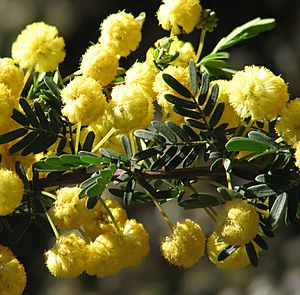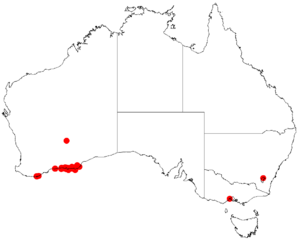Acacia nigricans facts for kids
Quick facts for kids Acacia nigricans |
|
|---|---|
 |
|
| Scientific classification | |
| Genus: |
Acacia
|
| Species: |
nigricans
|
 |
|
| Occurrence data from AVH | |
| Synonyms | |
|
Acacia ignorata K.Koch |
|
Acacia nigricans is a type of wattle plant. It is found only in a specific area on the south coast of Western Australia.
About the Plant
This plant is a type of shrub that usually grows between 0.4 and 2 meters tall. It has hairy branches with ridges. Small, leaf-like parts called stipules stay on the plant.
Its leaves are made up of smaller leaflets, arranged in pairs. These leaflets are usually oblong (a bit like a stretched oval) and are quite small, ranging from 3 to 8 millimeters long. The plant produces round, yellow flowers. You can see these flowers from the middle of winter to late spring.
How it Got its Name
Scientists give plants special names. This plant was first described in 1807 by a French scientist named Jacques Labillardière. He called it Mimosa nigricans. Later, in 1813, another scientist named Robert Brown moved it to the Acacia group. This is why it is now called Acacia nigricans.
Where it Grows
You can often find this wattle growing on sandy beaches, rocky hills, and among rocks. It prefers grey or white sandy soils along the southern coast of Western Australia. This area is part of the Goldfields-Esperance region.
Most of these plants grow from an area west of Esperance all the way to Israelite Bay in the east. They also grow inland near Howick Hill. You can also find them on several islands in the Recherche Archipelago. They usually grow as part of groups of small shrubs and plants.

